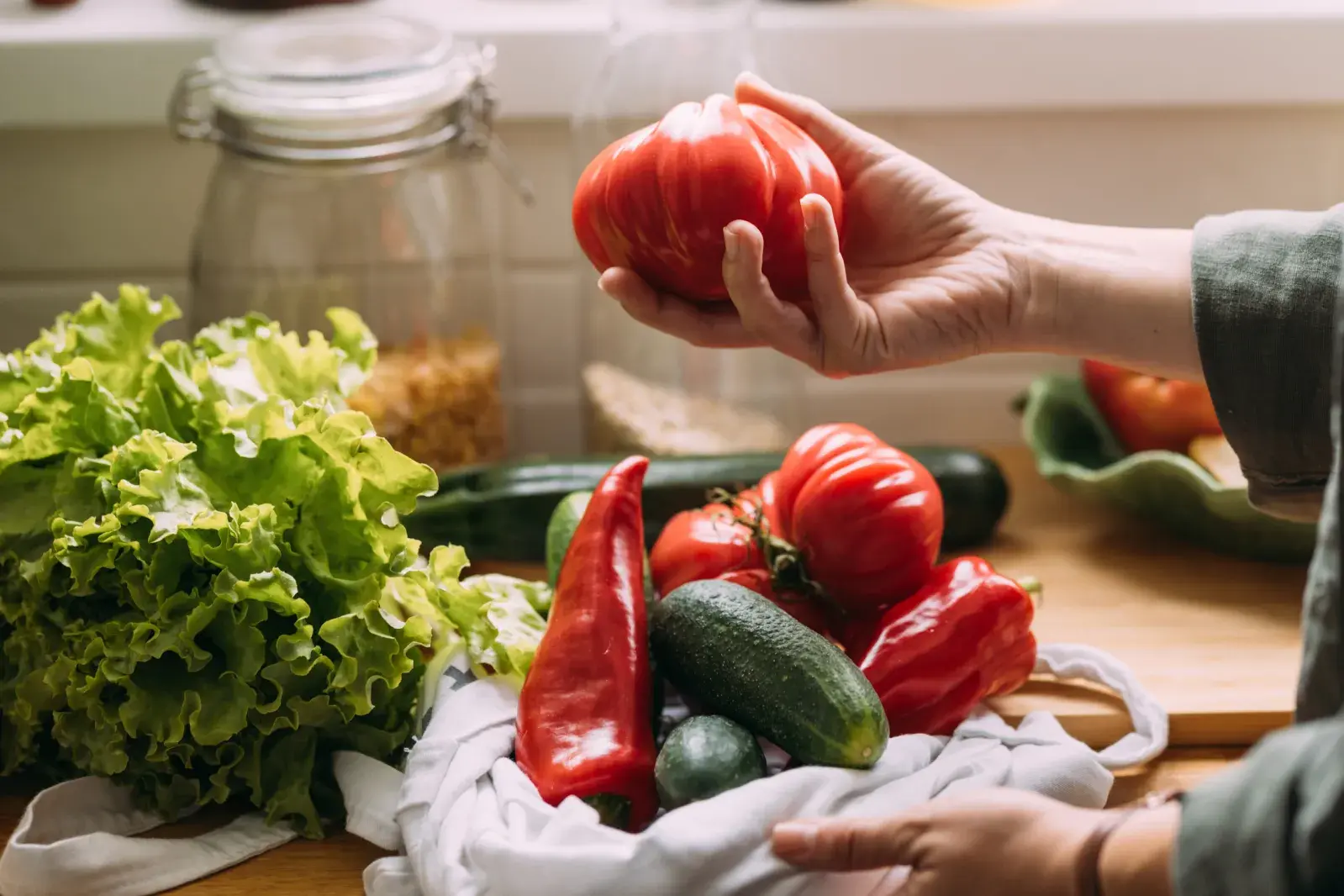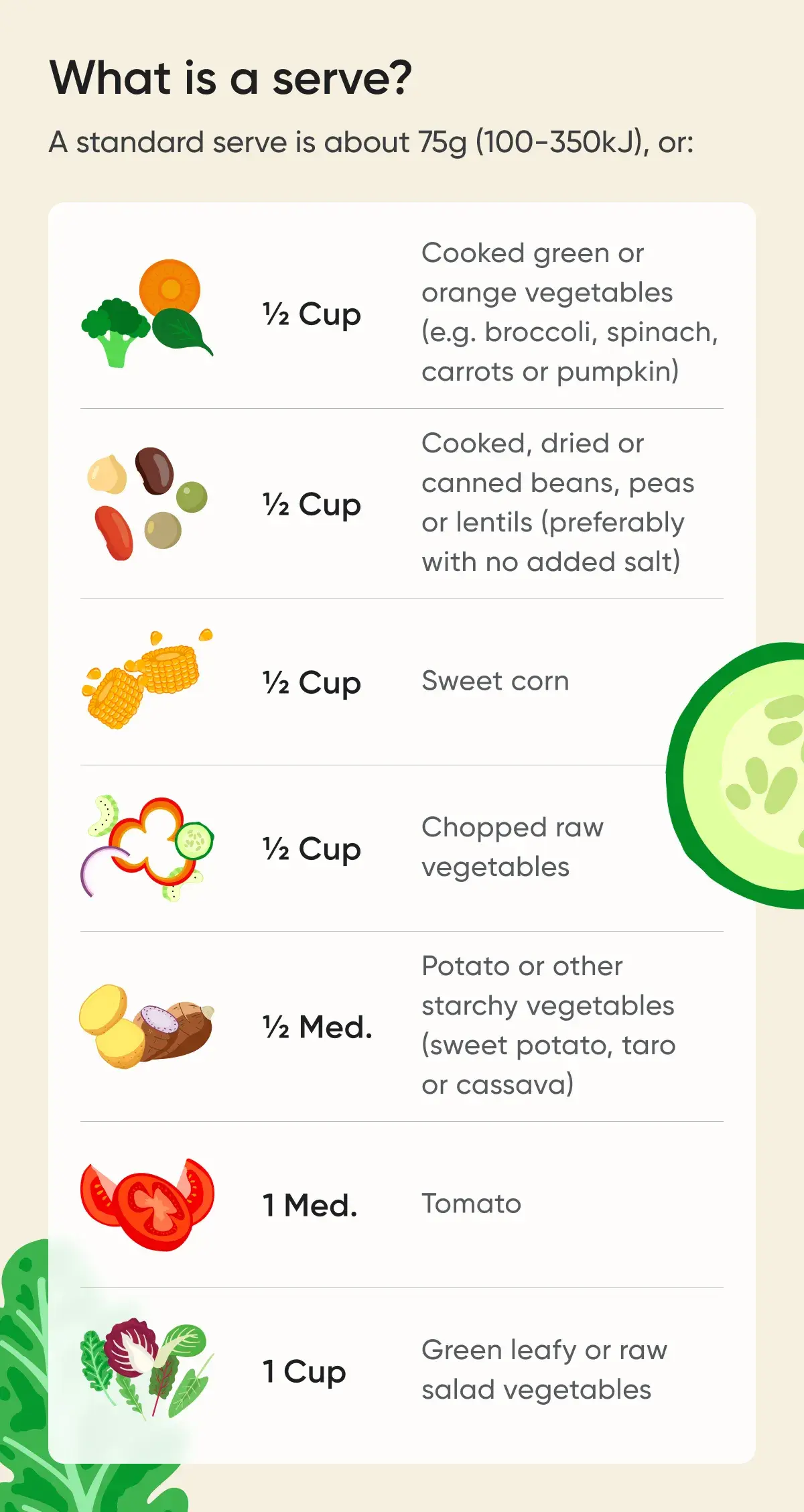How many servings of vegetables do you really need?

All vegetables are superfoods in my eyes: nutrient powerhouses waiting to be enjoyed for both their taste and health benefits. However, Aussies are only purchasing around half the recommended servings only of veg a day!
Get to know how many veggies you should be eating, plus some simple ways to up your serves each day.
How many servings of vegetables should you eat per day?
The Australian Dietary Guidelines recommend between:
- 5-6 serves of vegetables for adults
- 7 ½ serves when breastfeeding
- An increasing number of serves starting at 2-3 for toddlers 1-2 years of age, reaching 5 serves by age 11 and 5 ½ serves per day for boys 12-18 years.
This is a minimum number of serves, so knock yourself out with extra Brussel sprouts on your plate (delicious pan fried with a little onion and olive oil)!
What does a serving of vegetables look like?
A standard serve of vegetables is around 75 grams, (100-350kJ) or half a cup of cooked vegetables and one cup of leafy greens or raw salad. Remember legumes are counted in both the vegetable and meat and alternative food groups, with a serving in the vegetable group being around ½ a cup of cooked, canned beans.

One vegetable serve:
- ½ potato, sweet potato or other starchy vegetable (note: should form only part of your daily vegetable intake - variety is key!)
- ½ cup green or orange vegetables e.g broccoli, green beans, carrots, pumpkin
- ½ cup sweet corn
- 1 medium tomato
- ½ cup cooked, canned or dried legumes e.g green peas, kidney beans, lentils
When it comes to eating veg, meeting the recommended serves is important, as is the variety of veg you eat! By eating a range of different coloured vegetables this will help ensure you are getting a diverse range of nutrients from your diet. Aim to eat the rainbow: think red, orange, yellow, green, purple… the list goes on!
What are the benefits of eating more vegetables?
The scientific evidence for eating vegetables and their health benefits continues to strengthen. Your mother and grandmother, and probably theirs too, were already onto the benefits of vegetables and encouraging you to eat them up.
Vegetables range in the vitamins, minerals and other phytochemicals they provide, many with health protective effects against cardiovascular disease, stroke and high blood pressure. Vegetables are also low in fat, salt and sugar. They are also a good source of dietary fibre, which provides health benefits in itself for our gut health, bowel regulation and heart health to name a few.
Most vegetables provide vitamin C, a water soluble vitamin our body needs regularly as it doesn’t keep very much of a store. We often reach for fruit, particularly citrus, however remember that your veggies count towards your vitamin C intake too. In fact, in Australia, approximately 40% of the vitamin C comes from vegetables and 19% from fruits. Capsicum, cabbage, broccoli, kale and tomato are all valuable vegetable vitamin C sources of vitamin C.
Vegetables are also good for our skin health and its appearance, research suggests.
How you can hit your daily vegetable intake
For most of us, the target is 5 or more serves of vegetables a day according to the Australian Dietary Guidelines.
To track whether you are on target to hit this, Food Tracker, a free tool by Healthylife, can help you see if you have purchased enough vegetable serves for your household. It is free, easy to sign up, and you can compare how you are tracking for a week, fortnight or over the month. It also has tips on how to increase your serves and shows you where your serves are coming from. You could be getting vegetable serves in mixed meals such as a pasta sauce, veggie juice or soup that you didn’t even realise.
Here are some of my top tips on how to live life on the veg:
- Make your veggies taste good: Boiled zucchini doesn’t taste good. Some veggies need grilling, roasting or frying to bring out their best. Adding healthy oils such as extra virgin olive oil will help caramelise the natural sugars in the vegetables, making them taste sweeter and unlocking their flavour spectrum, bringing out the best in them! It can also suppress the bitter flavour that some brassica vegetables in particular have (broccoli, cauliflower).
- Plan your meal based on the veggies first: Rather than saying chicken is for dinner, why not say we are having roast pumpkin, mushrooms, zucchini and onions with roast chicken. That way veggies are not the afterthought but rather the feature of the meal and plate.
- Include some vegetables in each meal and snack: This could be baked beans at breakfast (as legumes count), salad in a sandwich or in a poke style bowl or soup with lunch, baby cucumbers and cherry tomatoes or hummus dip with carrots for a snack, and half the plate covered in veg at dinner time.
- Start the shopping list with the vegetables: including fresh, canned and frozen varieties so you don’t run out and have plenty of quick options (as they are nutritious in all forms!).
Do we really need five per day?
We sure do need to aim for 5 serves of vegetables a day (or a whopping 7 ½ if breastfeeding!), as there is so much research showing their health benefits. With many Australians suffering from a chronic disease, vegetables could be one of our answers to helping improve our long term health.
If you’re struggling with any nutritional areas, be sure to speak with your healthcare professional for support.
Curious if your groceries are on track to hit the recommended serves? Find out today with Food Tracker! Food Tracker takes the guesswork out of your groceries by showing you how many serves of vegetables you have, compared to the recommended amount. Join for free today.
This article is for informational purposes only and does not provide medical advice, diagnosis, or treatment. Any information published on this website or by this brand is not intended as a substitute for medical advice. If you have any concerns or questions about your health you should consult with a health professional.
